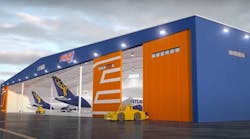Reading about business practices in the usual media outlets, aviation or otherwise, trade magazines, or text books describing best practices on the subject of business, you will undoubtedly come across writings about both successful and at times unsuccessful partnerships. A quick search for the definition of partner revealed such results as a person who shares or is associated with another in some action or endeavor; a principal or a contributor of capital in a business; a joint venture; sometimes sharing in the risks and profits. This includes of course one of the very important relationships, the one with your spouse. Partnerships can come in all sizes and shapes, between all types of companies, organizations, and individuals.
One type of partnership mentioned these days is the one between academia and the private sector for technical education. AMT provided examples of partnerships in our August focus on careers issue. The thought is the combined talents, experiences, resources, and lessons learned between the aircraft maintenance industry, an educational facility, manufacturing firms, and individuals can produce a better end result.
Other typical partnerships found in aircraft maintenance are those between an aviation operation and its suppliers and maintenance providers. I recall not too many years ago when suppliers were called vendors and often times not viewed as partners. These relationships were at times tenuous and all about the business with little mutual respect or benefit. But in the ever-changing landscape of business today, brought on in part by the economic conditions, globalization, mergers, and acquisitions, partnerships and partnering with key suppliers has become more important. The “go it alone” approach is not always viewed as the best or safest strategy.
Recently I sat down with Steve Hendrickson of Newcastle Aviation Partners, LLC. There’s that word partners; right in the name of his company. Newcastle provides a service of asset management particularly for those expensive spare parts such as turbine engines, propeller assemblies, and landing gear or related complex components. As described in the article partnering with a company to provide timely spare parts through exchange or lease arrangements, instead of outright ownership while maintaining your aircraft or fleet’s busy schedule, can be a beneficial partnership worth pursuing.
Other articles in this month’s issue of AMT include tire care and maintenance by Charles Chandler. Charles spoke with both Goodyear and Gulfstream and provides several of their current tips relating to tire care. Moving up to larger size tires and larger size operations, in this month’s MRO Operations feature Tim Kern describes the American Airlines Wheel &d Brake Center and how it produces 25,000 wheels and 5,300 brakes each year in order to keep the airline operating. There has to be some successful partnerships here.
As I write this column I am in Duluth, MN, preparing to attend the Cirrus Aircraft Partner Symposium. There’s that word again. Enjoy the issue, Ron


